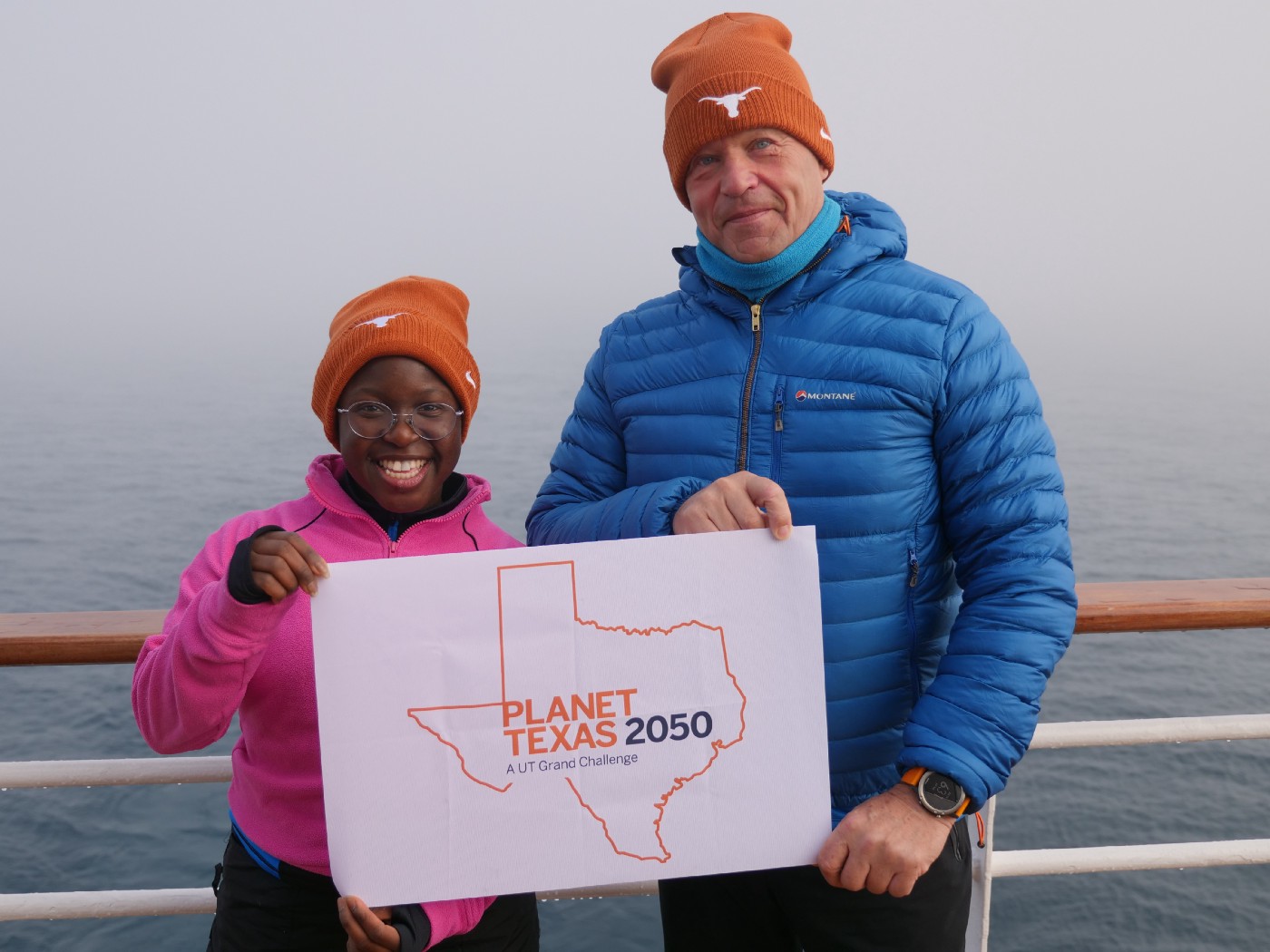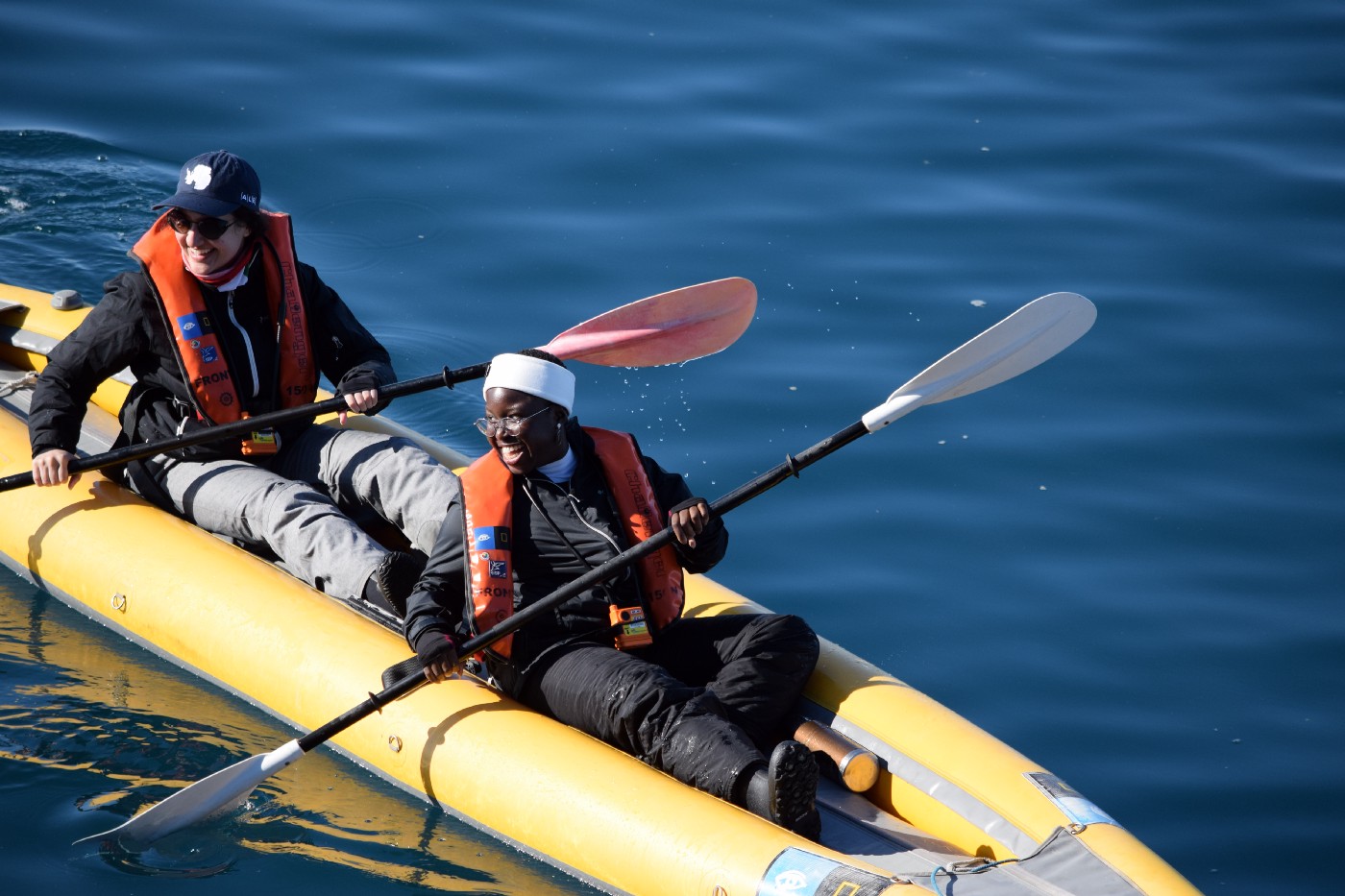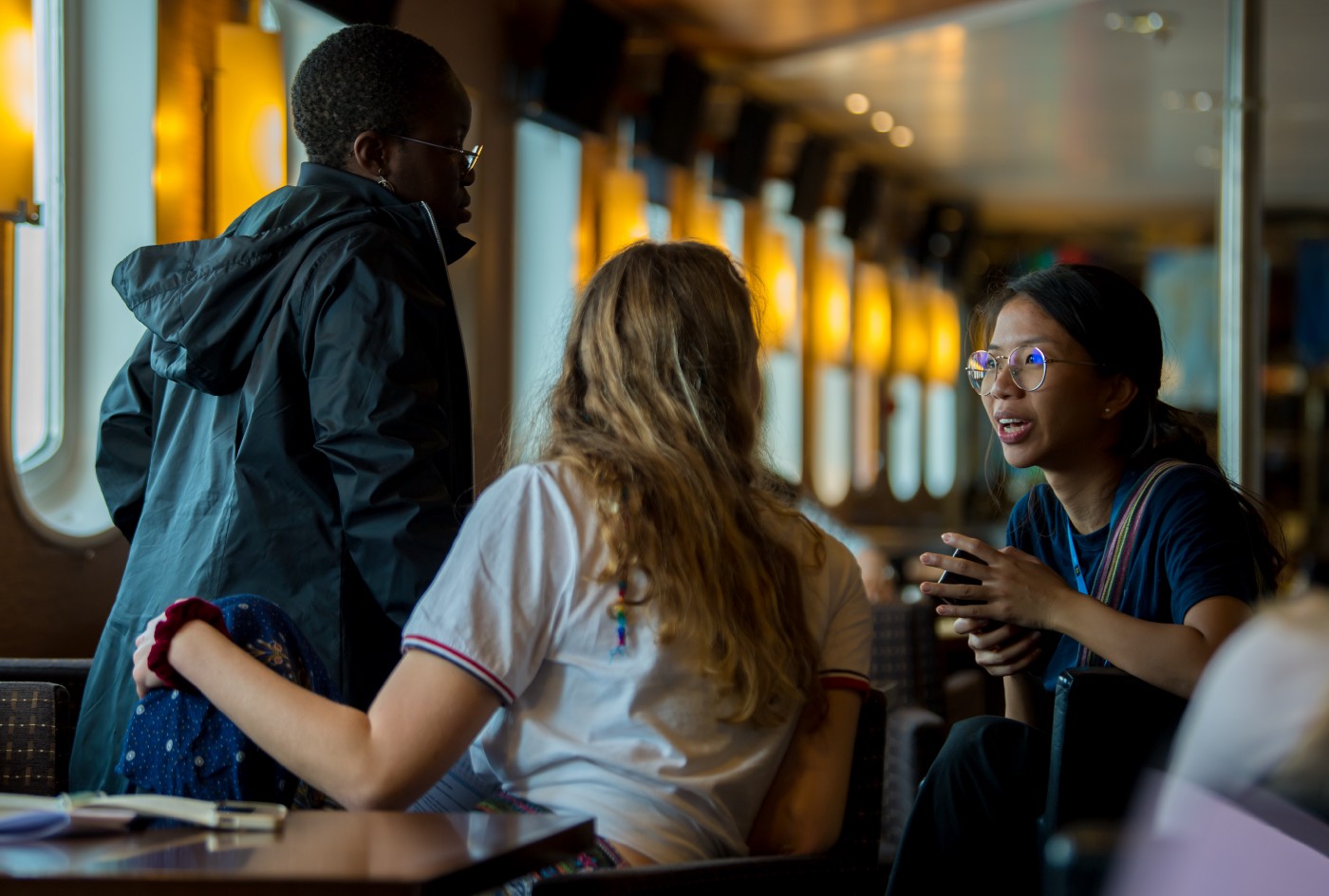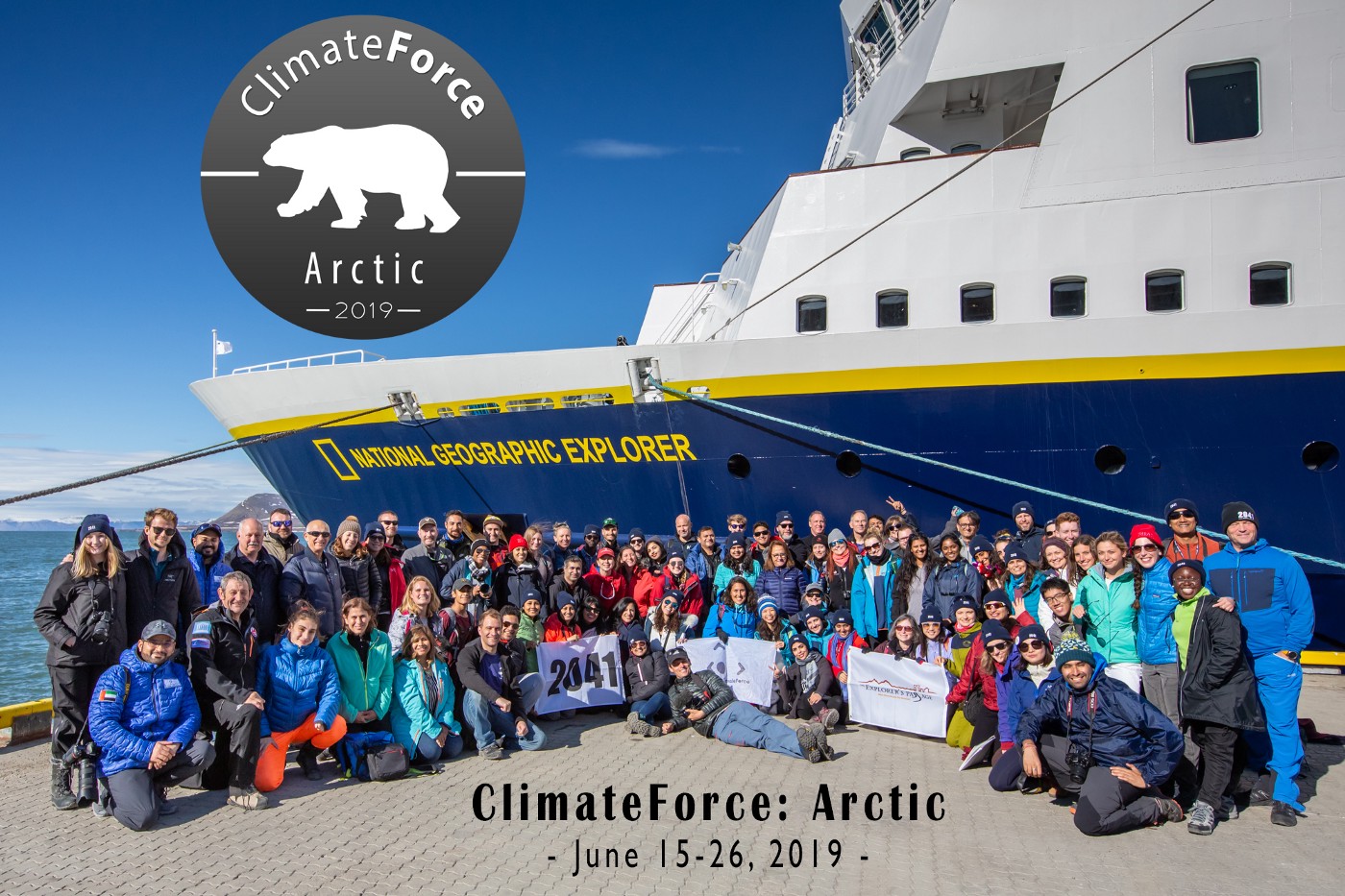Planet Texas 2050 sponsored Seyi Odufuye, a UT studio art major, to join a 12-day ClimateForce expedition in the Arctic with environmentalist and explorer Robert Swan. His ClimateForce team is dedicated to significantly reducing carbon emissions in the next five years, and students from around the world join him each summer to see firsthand one of the planet’s most impressive yet delicate ecosystems. These are Seyi’s thoughts and experiences from that journey.
Saturday, June 15, 2019
Oslo, Norway, 5:22 a.m.
From Austin to Chicago, Chicago to Frankfurt Germany, then finally to Oslo, Norway. After hours spent in the air and on layovers, I arrive in Oslo. The last time I was in Europe, I could barely walk, how much more remember. I’m honestly speechless! The airport is beautiful, and there is a full-fledged mall and what seems to be a mini grocery store. It is epic.
I take a train to Oslo Central Station and on the way there, I see so much green! Oslo is so beautiful; the landscape is breathtaking! I can’t stop myself from gasping. (I think the person sitting next to me was getting a little fed up.)
Later that evening, when I go to dinner, I’m just overwhelmed with awe. I’ve never seen train tracks built into a road! (Oslo’s Public transportation system seems to be very efficient.) With restaurants and shops on either side of a very broad walkway and roads for cars that cut perpendicular to the walkway, this city is made for people to walk and bike from place to place. The architecture is beautiful, the streets are clean, the buildings are high — and the prices of food are even higher. The sun didn’t go down until after 10 p.m. and by about 4:30 a.m., it was already waking up. Anyway, I had a lovely end to a lovely day, and I’m so excited about what this expedition has in store. I’m still trying to wrap my mind around the fact that I’m in Norway and will soon be headed to the Arctic in just a matter of days. I really don’t know what to expect. I’m approaching everything with an open mind.
Tuesday, June 18
Oslo, 4:07 a.m.
I reluctantly get out of bed to get ready for my 6:30 a.m. bus ride to the airport, headed for Svalbard, part of the Norwegian archipelago. I pack my bags, frustrated by the fact that what should have taken 30 minutes ends up taking an hour. After enjoying and stuffing myself with the wonderful breakfast spread one last time, I stand up, suck in my belly, and head for the bus.
Svalbard-Northern Norway/Southern part of Arctic
12:30 p.m.
As we are preparing to land in Svalbard, I look out my window. Like boiling water getting hotter and hotter, my excitement grows the more I get a glimpse of what I’ll be surrounded by for the next week.

Wednesday, June 19
Gnålodden, Svalbard
It was our first full day on the ship. The theme for the day was “Dream to Reality.”
I had a very early start to my day. My roommate (who seems pretty cool) and I went to the gym to work out and then we headed off to breakfast, which we had to finish by 7 a.m… I know! So early!
We went on our very first excursion today! Grabbing the hand of the two gentlemen in front of me, taking a wobbly step upon what looked like an empty blow-up swimming pool on a massive body of water, I stepped out on the zodiac with so much excitement welled up within me that I thought I would lose my footing and fall into the cold Arctic water (which I did end up doing… later on). After our short ride from the ship to the shore, we arrived at Gnålodden (Nagging Rock). Approaching the shore, I could hear the mating call of thousands of kittiwakes, a type of bird, that were nesting on the huge rock right before my eyes (hence the name of the place).

It was beautiful. The terrain was not close to what I was expecting (then again, I didn’t really know what to expect). During the days leading up to the expedition, blurry visions of high mountains, harsh winds, and my tired legs trudging through the thick snow replayed in my head, so to be met with green sponge-like lands, moss and tiny flowers with mild winds was a huge surprise. We did a bit of hiking and then headed back to the ship.
Friday, June 21
Arctic Sea
Sitting out on the deck of the ship with my laptop, looking out into the calm ferociousness of the vast sea spread before me, I breathe in the crisp air and shiver at every gust of wind that hits my body. I reflect on my time here thus far: the ambition, passion, and intellect of the people around me and the inspiration, ideas, and questions that being in such a space breeds. We had two wonderful excursions today, but I can’t stop thinking about tonight’s dinner. Other than the amazing food, my mind is fixated on a conversation that I had with two participants of ClimateForce: my roommate, who has already become a close friend, and a crew member of the ship named Jamie, who we call the bird expert.
With this, he pointed to a big problem in the scientific community: the lack of cooperation among different fields.
He talked about how he runs a research station where he was recently tagging penguins. Despite my initial lack of interest in the topic, I found myself drawn in the more I asked questions. Jamie worked with a woman engineering student who created a buoyant tagging device that keeps the instrument from weighing the animal down or hindering its agency. The tagging device allowed Jamie and his team to understand a lot more about penguins. It gathers information about the sounds they make and the sounds around them, the depth at which they swim, the number of times they attempt to catch food, the success of each attempt and so much more! He stated that rather than scientists trying to build such devices, and in doing so, operate outside of their field of expertise, he has found cooperation with experts in the field of engineering to produce better instruments and thus more detailed data.
With this, he pointed to a big problem in the scientific community: the lack of cooperation among different fields. That conversation then led to us discussing how cooperation with the media will allow scientists to effectively communicate gathered data to the public. Today, there’s a disconnect between the public and the scientific community, and one reason is that scientific findings are not conveyed in a way that is comprehensible for the general public. Jamie then went on to pose a very thought-provoking question, asking: In spaces such as this ship or in classrooms where people aren’t forced to listen to issues related to climate change, how do you catch people’s attention? We were all stunned by the question and couldn’t really come up with an answer right there and then.
Friday, June 25
Arctic Sea
Tonight was our last night on the ship, and it was beautiful to see everyone enjoying the company of each other: jisting, singing, laughing, smiling. Intently looking around at everyone’s faces, I realized how much I just love people — getting to know people for who they are, sharing moments and memories, stories, ideas, truths, beliefs, ambitions, and experiences with people. And that is exactly what I was witnessing right before me. It was a memorable sight.
Looking around, I realized that my story starts with my passion for hearing the stories of others. Behind each individual is a story: a reason why they do what they do, why they think the way they think, their passions, skills, personality, quirks, talents, interests, upbringing/background, beliefs and ideologies. It’s all a part of what makes them who they are. We can’t tell that just by looking at people.

Take Padmini, my roommate, for example. I never would have guessed she likes afro beats! Sis can dance! And Summit. He’s really into Yoga. Andy is full of ideas! Gustaf has a lot of wisdom to give. He is calm and collected and very good with talking to people. And who knew Kyle and John could both sing and play the piano! Trent is traveling the world, pursuing photography. And Alden, well he might just be one of the kindest people I’ve ever met. He’s a schoolteacher who is hungry to learn more about this issue of climate change so that he can bring that knowledge back to his classroom. And Shayna, as low-key and quite as she is, is a boss! I could go on and on about Jeff’s super inspirational story, Rishabh’s goofy self, the fire in Jessica and Anjuli, Barney, Vanya, Stephanie, Ameera, Shurooq, Raghav, Humaid, Ahmad, Sukriti, Yusuph, and so many others, but I truly wouldn’t be able to stop myself. I couldn’t have envisioned being surrounded by a better, more inspirational group of people. People with ambition, people who are authentic, people who have a willingness to learn, people who are humble and quiet, soft-spoken, wise, caring, passionate, sincere. And funny.
After our last dinner together, we sang the night away… at least, most of the team members did. As for me, I went up to my room to sleep, unbothered by the midnight sun and with satisfaction filling my heart.
Friday, November 15
Austin, 9 p.m.
After all this rambling, you might still be asking yourself, Why go all the way to the Arctic? Why not just sit in a convention hall and have seminars that last all day about climate change, storytelling, leadership, and steps moving forward?
Because of its high sensitivity to adverse conditions, [the Arctic’s] deterioration acts as an indicator of the danger to come or a possible explanation for what is already occurring in Texas and throughout the world.
First, it definitely wouldn’t be as fun. Second, I believe that being in the Arctic fostered experiential learning, granting participants the chance to better retain what was being taught. The unique opportunity to travel with the ClimateForce team gives individuals a way to connect on an emotional level with a part of the world that is hypersensitive to climate change while engaging in meaningful dialogue with professionals from all over the world. Additionally, such an experience will not simply have a hold on an individual’s intellect but on their heart as well, making it difficult for one to go back to their old lifestyle without making at least a minor change.
Now, what does this have to do with Texas, you ask?
The Arctic is like a canary in a coal mine. Because of its high sensitivity to adverse conditions, its deterioration acts as an indicator of the danger to come or a possible explanation for what is already occurring in Texas and throughout the world. In an email to me concerning what the Arctic has to do with individual states, David Hone, Chief Climate Change adviser at Shell International, says, “In the longer term, if the Arctic changes, then we may see a shift in conditions all over the world, but particularly the Northern Hemisphere, in part driven by changes in the jet-stream.” We should not only pay attention to what is happening in the Arctic but also do our best to protect it. Its downfall means our undoing.

This experience of journeying to the Arctic, engaging in thought-provoking conversations, and soaking up a wealth of knowledge left me with a broadened perspective on this issue. I came into a deeper understanding of the humanity of the issue, and my eyes were opened to the complexity of sustainability — that it’s not just an environmental issue but a social, political, and economic one as well. Now I’m a lot more conscious of my consumption, the waste I produce, and how I choose to use my buying power.
Moving forward, I hope to use cultural anthropology later on in my career to tell stories of the developing world and touch on issues of sustainability. That’s the plan, but as we all know, plans change. What won’t change is the fact that this expedition left me with a heightened appreciation for nature, a network of supportive professionals from all over the world, and storytelling and leadership tools that I will use to impact my community. In the near future, I hope to share my story at various schools in the Austin area and, by doing so, inspire younger people to take charge of their own futures and start conversations about sustainability. I’m confident that whatever I end up doing or becoming, I will serve the lives of others.
Going on this expedition, my intentions were to learn from others and have conversations that would spark possible solutions. I found that and so much more. Not just knowledge and skills but also a community.

